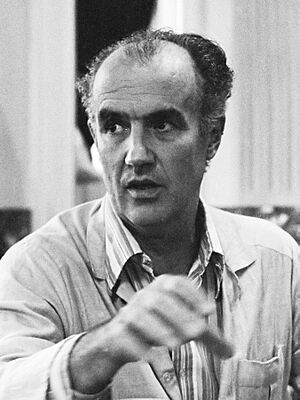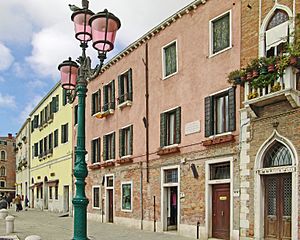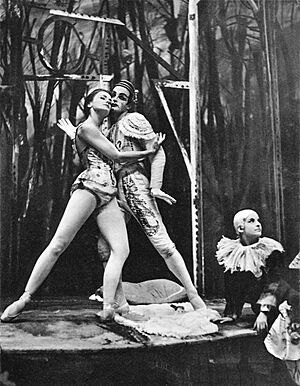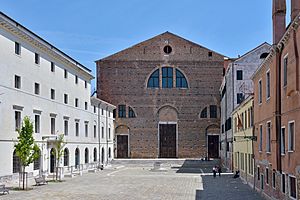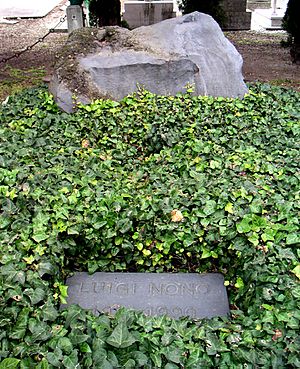Luigi Nono facts for kids
Luigi Nono (born January 29, 1924 – died May 8, 1990) was an Italian composer of classical music. He was known for his modern and experimental style.
Contents
Luigi Nono's Early Life
Luigi Nono was born in Venice, Italy. His family was wealthy and artistic; his grandfather was a famous painter. Luigi started learning music in 1941 at the Venice Conservatory. There, he learned about different music styles, including old Renaissance madrigals.
After studying law at the University of Padua, he was encouraged to compose music by Bruno Maderna. Maderna also introduced him to Hermann Scherchen, who became Nono's teacher and a big supporter of his music.
Scherchen helped Nono present his first major work in 1950. This piece, called Variazioni canoniche, showed Nono's strong feelings against fascism. Nono had even been part of the Italian Resistance during World War II. His political beliefs made him different from some other composers of his time. Still, Nono became one of the most important leaders in new music during the 1950s.
The Darmstadt School and New Music
Many of Nono's early works were first performed at a special music course in Darmstadt, Germany. These included Tre epitaffi per Federico García Lorca (1951–53) and La Victoire de Guernica (1954). The latter was a protest against wartime cruelty, much like Picasso's famous painting.
In 1955, Nono married Nuria Schoenberg, the daughter of composer Arnold Schoenberg. He had met her two years earlier. Nono joined the Italian Communist Party in 1952, showing his strong political views.
Il canto sospeso and Its Impact
Nono gained international fame with his work Il canto sospeso (1955–56). This piece was for singers, chorus, and orchestra. People were amazed at how Nono combined modern music with deep emotions.
One reviewer said Nono proved that modern music could be powerful and moving. This work is seen as a masterpiece of the 1950s. It remembers the victims of Fascism and uses farewell letters written by political prisoners. Nono used voices in a new way, breaking words into syllables. This created unique, floating sounds.
Il canto sospeso is a powerful reminder against cruelty. Nono continued to write about anti-fascist themes. For example, Diario polacco (1958–59) was inspired by a trip to Nazi concentration camps. His stage work Intolleranza 1960 even caused a riot at its first performance in Venice in 1961.
The "Darmstadt School"
In 1958, Nono used the term "Darmstadt School" to describe the new music being created by him and other composers like Pierre Boulez and Karlheinz Stockhausen. He thought their work was as important as the Bauhaus movement in art.
However, Nono later disagreed with some of his friends, like Stockhausen. Nono believed that music should have a clear message and not be left to chance. This disagreement led to the end of their close friendship for many years.
Nono's Music in the 1960s and 1970s
Intolleranza 1960 showed the peak of Nono's early style. This "stage-action" (Nono didn't want it called an "opera") told the story of an immigrant facing exploitation, arrest, and concentration camps. It used a large orchestra, chorus, tape recordings, and loudspeakers. The story included political slogans and quotes from famous writers like Bertolt Brecht. The riot at its premiere showed how strongly people felt about its political message.
During the 1960s, Nono's music became even more direct in its political messages. He wrote about nuclear danger (Canti di vita e d'amore, 1962), capitalism (La Fabbrica Illuminata, 1964), Nazi war crimes (Ricorda cosi ti hanno fatto in Auschwitz, 1965), and the Vietnam War (A floresta é jovem e cheja de vida, 1966).
Nono started using recorded sounds like political speeches and slogans in his music. He also used new electronic sounds. He felt these were needed to create "real situations" related to current political issues. He often took his music to universities, unions, and factories.
Al gran sole carico d'amore
Nono's second major stage work was Al gran sole carico d'amore (1972–74). In this large piece, Nono didn't use a traditional story. Instead, he presented important moments from the history of Communism and class struggles. The work explored failed revolutions, like the Paris Commune of 1871 and the 1905 Russian Revolution. It was a deep look at the history of 20th-century communism through Nono's music. It premiered in Milan in 1975.
Nono traveled a lot during these years, giving lectures in Latin America. He met many important left-wing thinkers. He composed Como una ola de fuerza y luz (1972) to honor Luciano Cruz, a leader of the Chilean Revolutionary Front. This piece used a large orchestra, tape, and electronics.
Nono then wrote ... sofferte onde serene ... (1976) for his friend, pianist Maurizio Pollini. This work marked a new, more personal phase in Nono's music. It led to Fragmente-Stille, an Diotima (1980) for string quartet. This piece is very quiet and challenging. It includes hidden quotes from the poet Friedrich Hölderlin.
The 1980s and Prometeo
In the 1980s, Nono was influenced by the philosopher Massimo Cacciari. Nono became interested in the ideas of German philosophers, especially Walter Benjamin. Benjamin's ideas about history were very similar to Nono's own. These ideas became the basis for Nono's huge work, Prometeo—tragedia dell' ascolto (1984/85).
Prometeo was first performed in the Church of San Lorenzo in Venice in 1984. It was conducted by Claudio Abbado. This piece is often called one of the best works of the 20th century. Nono called it a "tragedy of listening," meaning it was a drama in music without a visual stage.
Nono also started experimenting with new sound technologies in Freiburg, Germany. He worked with musicians and technicians to create new ways for sound to move in space. This became very important in his music, especially in Prometeo.
Prometeo is seen as the ultimate example of Nono's "theater of consciousness." It's an invisible theater where sound and its movement in space are key. The architect Renzo Piano designed a large wooden structure for the premiere. The text for Prometeo included writings by Hesiod, Hölderlin, and Benjamin. Nono believed that music and sound were more important than images or words in creating new meanings.
In 1985, Nono found a saying in Spain: "Travellers, there are no trails – all there is, is travelling." This phrase deeply affected him. He used it as inspiration for his last three works.
Nono's final pieces, like Caminantes... Ayacucho (1986–87), were inspired by a poor region in Peru. These works, along with La lontananza nostalgica utopica futura (1988–89) and "Hay que caminar" soñando (1989), showed his lifelong search for social justice.
Luigi Nono died in Venice in 1990. He is buried on the Isola di San Michele in Venice, near other famous artists. His music and ideas continue to inspire many, including architects and writers. The Luigi Nono Archives were created in 1993 to preserve his important work.
Images for kids
See also
 In Spanish: Luigi Nono para niños
In Spanish: Luigi Nono para niños


